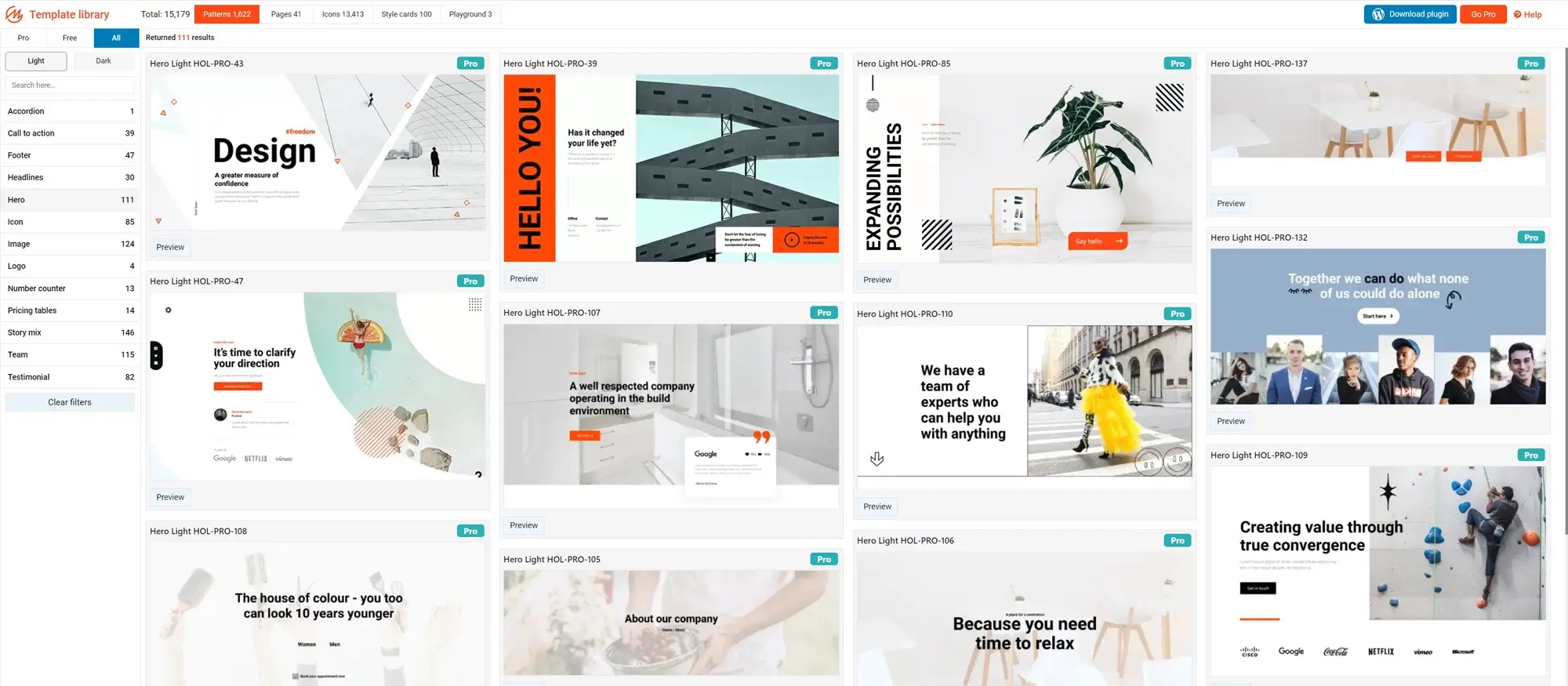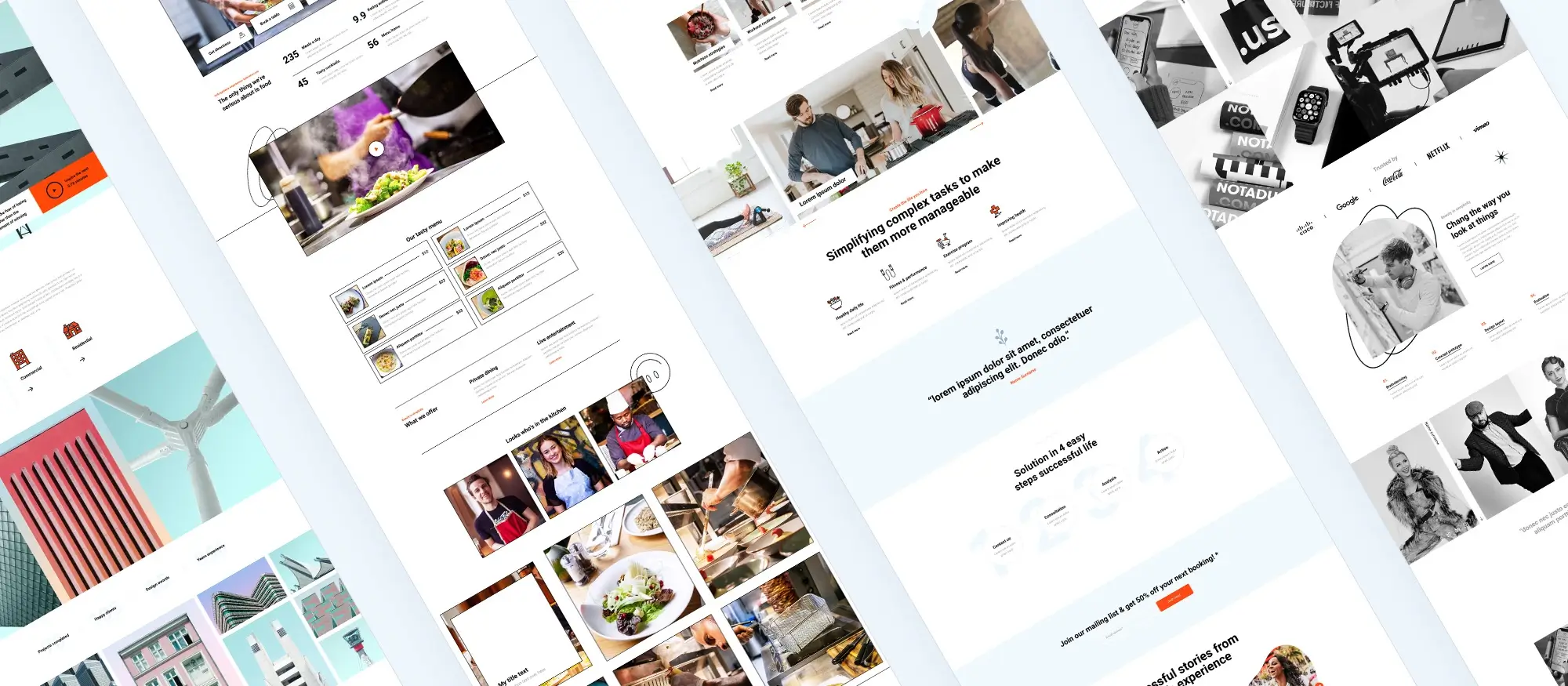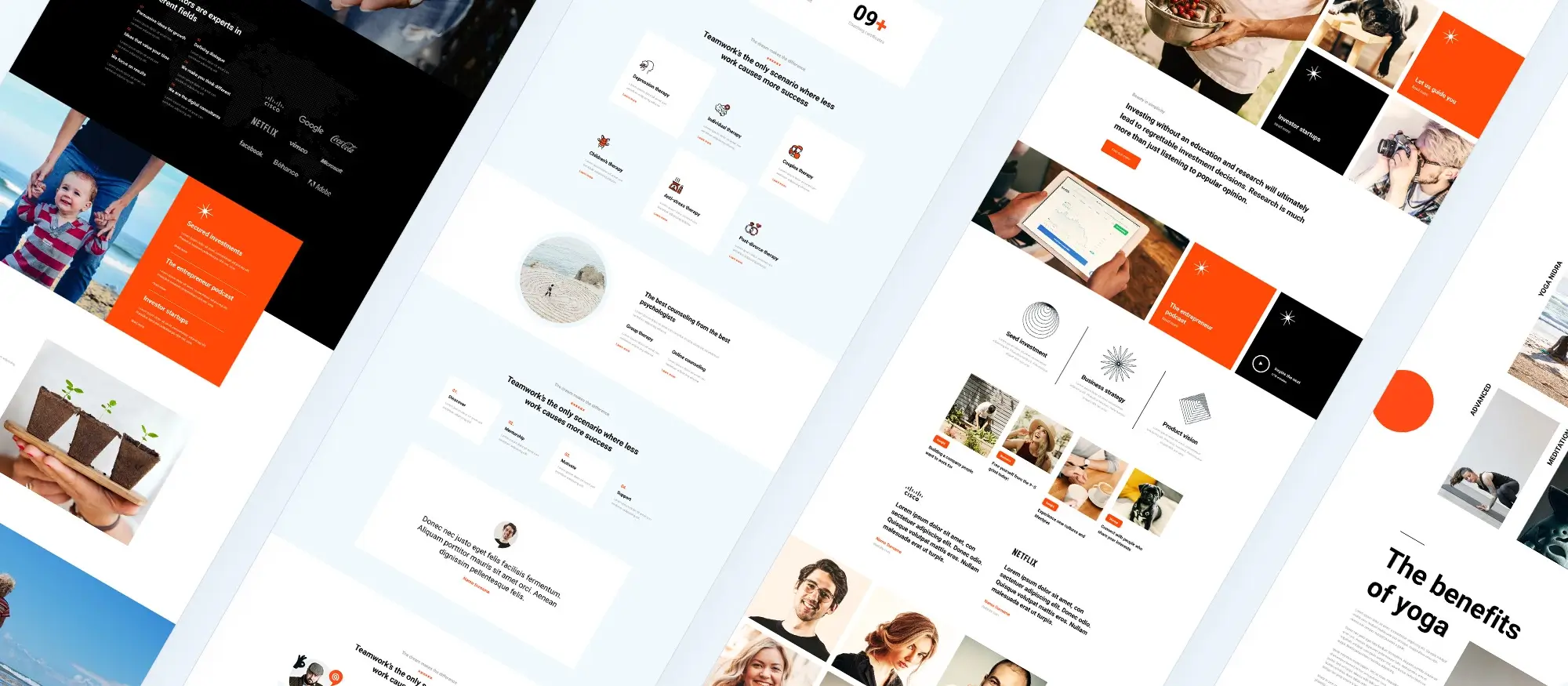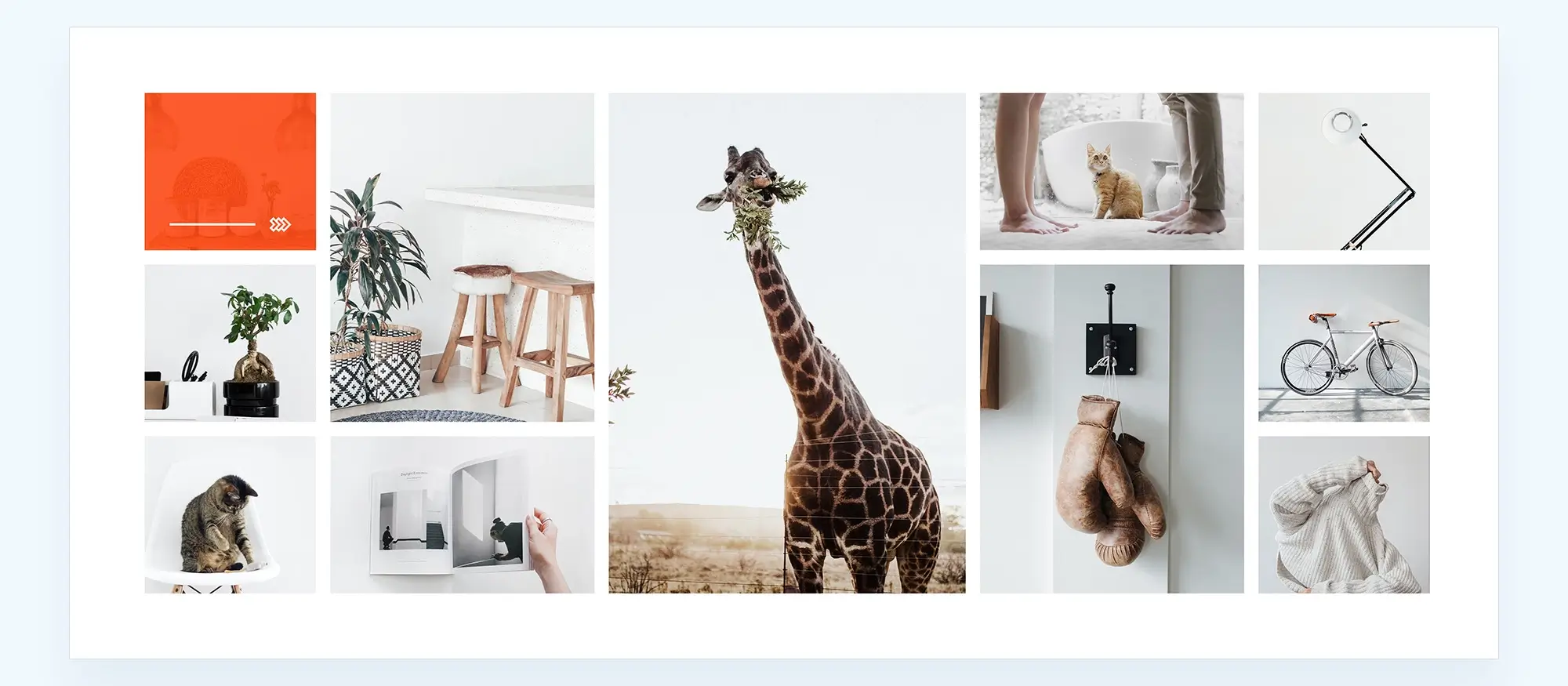WordPress block templates: a comprehensive guide
Try MaxiBlocks for free with 500+ library assets including basic templates. No account required. Free WordPress page builder, theme and updates included.

Updated 8th May 2025
Key takeaways:
- WordPress block templates simplify website building, allowing designers to create dynamic and responsive sites quickly.
- Gutenberg’s block editor provides greater flexibility in design.
- WordPress block themes and full site editing let designers implement consistent changes site-wide.
- Custom block templates leverage HTML, PHP, and JavaScript for advanced and rich designs.
- Plugins enhance Gutenberg’s capabilities, expanding functionality tailored to specific website needs.
What are WordPress block templates?
WordPress block templates offer a streamlined method for creating and organising web content without extensive coding. They utilise a modular approach called “blocks,” which manage different types of content, including text, images, and videos, enabling intuitive content organisation.
Block templates are composed of specific parts such as headers, footers, and main content sections. By combining these reusable elements, designers can efficiently build coherent and visually appealing pages or entire websites.
Using block templates, WordPress web designers can quickly produce professional, responsive, and dynamic websites, significantly reducing development time compared to traditional coding methods.

WordPress block templates: a shift in web design
Introduction of WordPress block templates
WordPress block templates were introduced with the release of WordPress 5.0 in 2018. These pre-designed layouts are made up of reusable content blocks, similar to building blocks, that can be easily customised to create new page or post layouts.
Block templates simplify the website design process by eliminating the need for extensive coding knowledge, making it more accessible for designers of all skill levels. Users can select a suitable pre-designed template, customise the content and layout, and quickly publish their page or post.
Development of WordPress block templates
The journey towards WordPress block templates has been gradual. Before block templates, users relied heavily on page builders and themes for custom page layouts, which required significant coding skills and were not always user-friendly for beginners.
With the release of WordPress 5.0, also known as “Gutenberg,” the block editor introduced a more straightforward method for arranging content blocks. Although Gutenberg represented an improvement over the classic editor, users still needed to manually build layouts.
The introduction of block templates in later WordPress versions significantly simplified this process by providing ready-made layouts that could be easily adapted to various needs.
Advantages of using WordPress block templates
The primary benefit of using WordPress block templates is their ease of use. Web designers do not need extensive coding or design experience, allowing them to build professional websites more quickly and efficiently.
Key advantages include:
- Ease of Customisation: Templates can easily incorporate branding elements and design preferences.
- Flexible Layouts: Blocks can be quickly rearranged, added, or removed, enabling effortless design adjustments.
- Mobile and SEO Optimisation: Templates are generally optimised for mobile responsiveness and SEO, ensuring fast, accessible websites.
Practical examples of WordPress block templates
A freelance photographer might use block templates to rapidly create a portfolio showcasing various photography styles, maintaining a consistent layout with reusable blocks. Block templates also benefit e-commerce businesses by facilitating quick creation of product pages, contact forms, and blog posts, ensuring a seamless user experience across devices.
Subscribe to our newsletter
Understanding block templates in WordPress
What are block templates?
Block templates are collections of predefined content blocks with attributes or placeholder content. They provide default layouts for editor sessions, enhancing design consistency and simplifying content creation within the WordPress editor.
Gutenberg and the WordPress block editor
Evolution from the classic editor
WordPress continuously evolves, and Gutenberg represents one of the most significant changes in recent history. Released in 2018, Gutenberg replaced the classic editor’s limited capabilities with a modern, block-based system. Named after Johannes Gutenberg, inventor of the printing press, the editor revolutionised content creation, allowing each element (text, images, video) to be individually adjustable.
Benefits of Gutenberg editor
The Gutenberg editor aimed to simplify WordPress site creation, reducing dependence on shortcodes, custom post types, and external page builders. It empowers users to create complex layouts, design pages intuitively, and supports full site editing within WordPress itself.
Block themes and full site editing (FSE)
What are WordPress block themes?
Block themes expand Gutenberg’s capabilities to entire websites, turning headers, footers, sidebars, and content areas into customisable blocks. This holistic approach allows comprehensive site-wide adjustments directly within the block editor, unifying content and design processes.
Practical example of block themes and FSE
A small business owner can leverage block themes and full site editing to quickly launch and manage their website independently. They customise everything from headers to footers using intuitive, pre-built blocks for services, contact forms, and blogs, ensuring consistent branding without needing coding skills.
Exploring the new site editor and full site editing features
The new site editor extends beyond traditional page and post editing, enabling users to design and customise their entire website directly from the WordPress dashboard. Real-time live previews help reduce the iterative back-and-forth between editing and viewing changes, streamlining the design process significantly.

How block themes differ from traditional WordPress themes
From fixed templates to flexible layouts
Traditional WordPress themes came with predefined designs, layouts, and functionalities. Customisation often required knowledge of PHP, CSS, or adding custom code snippets. Block themes shift this approach entirely, focusing on user-driven design with minimal coding. Instead of relying heavily on hard-coded templates, users can easily craft custom layouts, create unique templates, and reuse designs across their website seamlessly.
User-driven design
The introduction of WordPress block themes has moved the design process from a rigid framework to an adaptable, intuitive experience. Users can visually create and modify page layouts directly in the editor, significantly reducing development time and complexity.
The role of template parts in building a complete website
Modular web design
Template parts act as modular, reusable sections that can consistently apply across your entire website. Common template parts include headers, footers, sidebars, and content areas. Their modular nature ensures design consistency, allowing a single change to a template part to update all instances across the site automatically.
Enhancing consistency and efficiency
For example, a web designer might create custom headers and footers as template parts. Any edits made such as updating a logo automatically propagate across every page, streamlining updates and ensuring consistency.
Continuous innovation with new blocks
The WordPress block system continually expands by introducing new blocks, enhancing customisation possibilities. Examples include the Query Loop block, enabling dynamic content displays, and the Site Logo block for simple brand integration. Each block offers customisation options, granting users flexibility to tailor the design precisely to their needs.
Use Case: Template parts in action
A freelance web designer uses template parts to maintain uniformity across multiple client websites. Creating a custom header and footer as template parts, they ensure site-wide consistency. When clients request changes, such as a new logo, updates made to the header template part automatically reflect on all website pages, significantly reducing the time spent on repetitive tasks.
Custom block templates: combining HTML, PHP, and JavaScript
The technology behind block themes
Custom block templates integrate multiple web technologies to produce dynamic and interactive content. They employ HTML for structure, PHP for fetching dynamic content, and JavaScript for interactive elements. This combination allows for sophisticated and rich designs that transcend simple visual appeal.
Expanding design possibilities
Advanced users can craft intricate block markups, create interactive components, and customise their websites beyond the capabilities of traditional WordPress themes.
Build like a pro
Structuring content with layouts in the block editor
Layouts as structural foundations
Layouts within WordPress block templates serve as the foundational framework for organising and displaying content clearly. They ensure logical and consistent presentation, whether for landing pages, blogs, or product showcases.
Pre-designed block patterns
WordPress block templates offer pre-made block patterns such as headers, testimonials, or product sections to simplify web design. These predefined patterns not only provide design consistency but also speed up the process, reducing time spent designing repetitive sections.
Customisable grouped blocks
Another essential feature is grouping blocks, enabling users to create unified sections such as product showcases, testimonials, or contact forms. These grouped blocks streamline site management and ensure future updates remain easy and consistent.
Use Case: Leveraging layouts effectively
A small business owner leverages layout tools in the block editor to design a product landing page swiftly. By using pre-made block patterns for testimonials and product highlights, the business owner maintains professional quality and consistency without complex coding. Easily customisable layouts allow the page to match brand colours and styles, effectively reflecting the company’s identity. Grouping related content blocks simplifies future updates and ensures ongoing structural consistency across the site.
Customizing your website
To build a website that showcases your brand identity, you need to know the various elements involved. Here’s an overview of how you can customize your site to match your vision:
Your header is the first impression visitors get of your site. You can customize it to match your brand identity by adding a distinctive logo and selecting fonts that suit your style. With block templates, you can easily create and edit your header without coding skills.
Adjusting the content to make it your own
It includes sample content, the title of a post, and the URL (or slug) that takes people to specific pages. By adjusting these elements, you can add a personal touch that makes your website feel more like your own.
A well-designed footer can make your website look better and work better. With WordPress templates, you can customize widgets, fonts, and other features to fit your brand’s style and vision.
Creating a website that’s both functional and attractive often requires more than just choosing a great theme. Plugins are additional tools that can add more features to your website, working with the editor. Let’s look at how you can improve your templates with plugins:
The editor in WordPress is powerful on its own, but with the right plugins, you can significantly improve its capabilities.
Widgets and custom post types
Plugins can introduce new widgets, enable custom post types, and add many other features that extend the editor’s capabilities. Whether you need special content layouts or additional e-commerce functionalities, plugins can provide solutions that are tailored to your website’s requirements.
Plugins in the repository
You can improve a theme with various plugins from the repository. These plugins offer features like SEO optimization and social media connectivity. It’s important to choose plugins that match your theme and align with your website’s goals and audience.
A theme can benefit from plugins that complement its design and functionality, rather than cluttering it with unnecessary features. The editor and plugins work together to enable you to build a website that meets your specific requirements and preferences. You can find a wide range of plugins in the WordPress repository that suit any theme.

Crafting a blog or online store with Gutenberg blocks
Gutenberg has transformed the way we create websites on WordPress. Whether you’re looking to set up a personal blog or an online store, these provide a flexible and user-friendly approach. Here’s a guide to help you navigate this process:
Setting up a blog or an online store might seem complex, but with Gutenberg blocks, it becomes a manageable task. By understanding your site’s purpose and target audience, you can choose the right blocks to create a cohesive and engaging experience.
Utilizing starter templates for easy website creation
If you’re just starting with building websites or want to save some time, using a starter theme is a great idea. These themes are already designed and have different sections arranged in a nice, appealing way.
Smooth user experience with custom template and front-end editing
For those who want a more personalized touch, the default page template in the WordPress Gutenberg editor allows you to design layouts that match your unique vision.
Crafting a blog or online store with patterns and minimal design
Building a blog or online store doesn’t have to be an overwhelming task. With the Gutenberg editor, you have access to WordPress patterns, typography choices, and style variations.
The easy way to add a custom logo, post title, and other elements to your site is by leveraging the full site editor along with the page template. New themes and style variations give you the flexibility to create a minimal design that reflects your goals. Whether you’re a seasoned pro or just starting, these tools can help you craft a professional and authentic online presence with ease.
Exploring the directory to find various templates and styles
If you’re unsure about designing from scratch, the directory offers a collection of templates and styles. You can browse different categories to find something that resonates with your vision or the purpose of your site. These themes can be customized further, giving you a perfect balance between convenience and uniqueness.
Starting with a blank slate and transforming it into a professional-looking site
With the editor, directory of templates, and the flexibility to start with a blank canvas, you have all the tools you need. Take your time to explore and play around, and soon you’ll be crafting professional and authentic websites with confidence. Whether it’s a blog, online store, or personal portfolio, making the most of WordPress is within your reach.
Why WordPress block templates are changing how websites are built
If you’re building a WordPress site today, it’s worth exploring how much easier things have become with the rise of WordPress block templates. These modular, reusable layouts allow you to create professional designs with minimal effort, giving you the flexibility to adapt each section of your site without having to start from scratch.
The future of site building is clearly shifting toward this approach, and the future of WordPress block templates explains how this technology is reshaping design workflows. For example, if you’re looking to start a new WordPress site, block templates make it easy to quickly assemble pages using pre-designed elements.
Sites like MaxiBlocks offer an extensive library of block templates for WordPress, including free WordPress templates for anyone just getting started. You can browse everything from complete website templates for WordPress to niche-specific WordPress website design templates.
Need to promote your content? Try WordPress block templates for social media to align your site’s look and feel with your channels. If you’re after complete control, you can start with a single block template and customise it however you like.
Understanding how to use WordPress themes also helps ensure a smooth experience when working with WordPress websites templates. Combined with WordPress website templates, block-based design opens up new creative possibilities without the usual technical barriers.
Whether you’re launching a blog, a business site or an online portfolio, WordPress block templates offer a smarter, faster and more flexible way to get online.
WordPress template sites for fast and easy design
Explore flexible WordPress templates with built-in styles and block layouts for faster design.
What is a block template in WordPress?
A block template is a predefined layout made up of various blocks used to create consistent content structures in WordPress. These templates help ensure key content elements appear in a specific order on pages or posts.
How to create a block pattern in WordPress?
To create a block pattern, arrange blocks in the desired layout in the Block Editor (Gutenberg), select them, click the three-dot menu, choose “Add to Reusable Blocks”, and save. For advanced use, register the pattern programmatically using register_block_pattern in your theme or plugin.
How to make a block template in WordPress?
To create a block template, add a new PHP file in your theme, define the layout using register_block_template, specify the block types and order, then assign the template to a page or custom post type.
How to use WordPress block themes?
Install and activate a block theme from the WordPress Theme Directory. Use the Site Editor to customise layouts, add blocks, edit content visually, and save changes to apply them site-wide.
What’s the main purpose of building block templates?
Block templates are designed to maintain consistent layouts and streamline content creation. They simplify the process of building pages and ensure design uniformity without requiring coding skills.
What is the purpose of blocks in WordPress?
Blocks allow you to manage content modularly. Each block represents a type of content text, image, video, gallery and can be easily rearranged or styled in the editor, offering flexibility in layout and design.
What is the difference between a widget and a block in WordPress?
Widgets are used in sidebars and footers for static content across a site. Blocks are dynamic elements used in the Block Editor to build content directly on posts and pages, offering more flexibility and visual control.
How to customise WordPress block templates?
Open the Block Editor, load the template, and make changes to blocks update text, rearrange elements, or change styles. Save the template to apply updates across all assigned posts or pages.
Can WordPress block templates be shared across different sites?
Yes. Export the template code from one site and import it into another manually or using a plugin that supports cross-site template sharing.
How do WordPress block templates improve content management?
They streamline content creation by offering predefined layouts, reducing repetitive design work, and ensuring consistency across pages, improving efficiency and user experience.
Are WordPress block templates compatible with all themes?
Block templates are supported by block-compatible themes. Older or classic themes may not fully support these templates, so it’s best to use themes that support the Gutenberg block editor.
How to export and import WordPress block templates?
Copy the block template code from the theme’s PHP files or use a plugin with export features. To import, paste the code into the new theme’s appropriate template files or use a supported plugin.
What are best practices for designing WordPress block templates?
Keep layouts simple and clear, use reusable blocks, test responsiveness on various devices, and document the structure for easier updates or collaboration.
How to troubleshoot issues with WordPress block templates?
Check template code for syntax errors, ensure plugins and themes are up to date, test different blocks to isolate issues, and consult WordPress documentation or support forums if needed.
How can developers extend WordPress block templates?
Developers can extend block templates by building custom blocks, using hooks and filters, integrating plugins, and contributing to WordPress core to enhance block functionality.
What resources are available for learning WordPress block templates?
Visit the WordPress Developer Handbook, explore online tutorials, courses, blogs, and engage in WordPress forums and communities for continuous learning.
WordPress itself
Official Website
wordpress.org – This is the official website for WordPress, where you can download the software, find documentation, and learn more about using it.
WordPress Codex
codex.wordpress.org/Main_Page – This is a comprehensive documentation resource for WordPress, covering everything from installation and configuration to specific functionality and troubleshooting.
WordPress Theme Directory
wordpress.org/themes – The official WordPress theme directory is a great place to find free and premium WordPress themes. You can browse themes by category, feature, and popularity.
maxiblocks.com/go/help-desk
maxiblocks.com/pro-library
www.youtube.com/@maxiblocks
twitter.com/maxiblocks
linkedin.com/company/maxi-blocks
github.com/orgs/maxi-blocks
wordpress.org/plugins/maxi-blocks

Kyra Pieterse
Author
Kyra is the co-founder and creative lead of MaxiBlocks, an open-source page builder for WordPress Gutenberg.
You may also like

